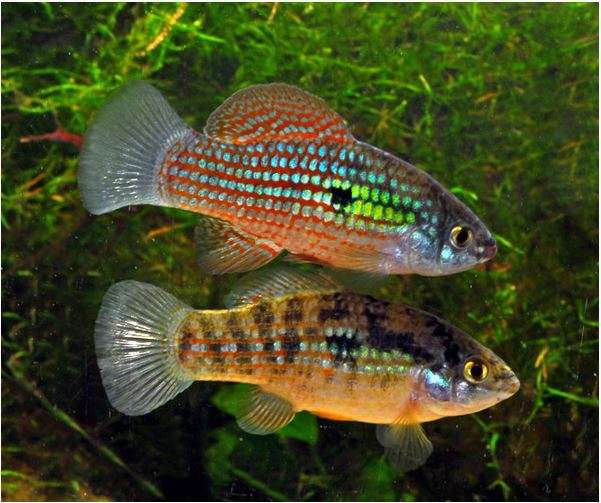
Size
2 – 2.2 inches
Physical Characteristics
Compared to most other cyprinodonts, the body is considerably shorter and more laterally compressed. It should belong in its own genus because of its distinct spiny fin rays and odd anatomy. Both sexes have comparable bodies. It has a distinctive profile thanks to its flattened sunfish-like shape and its dorsal and anal fins’ rearward displacement. It rivals the dwarf gourami in overall appearance and is without a doubt the most colorful of our native aquarium fishes.
Temperament
The typical activity is a patient, dignified quest for algae and a tranquil resting position among top weeds, like many partially vegetarian fish. The resting position could be closer to the plant bases in shallower tanks. When not breeding, a mated pair will spend most of their time together, stroking and brushing each other affectionately. Rarely will they let the other person out of sight. More aggressive species can make the floridae scared and hide, although rarely harassing others. Like all killies, the young do scream in alarm, but this usually passes as they get older. Tiny newborns can be challenging to see. With the slightest hint of the tank, they immediately dive for shelter.
Habitat
This magnificent fish inhabits the rivers, marshes, floodplains, and ditches of Florida all the way down to the Yucatan Peninsula. They are now primarily captive-bred in fish farms and may be found in pet shops and aquariums all over the world.
Keeping as Pet

- Tank Size
If you obtain a male that is a little territorial, we would advise a tank that is at least 10-15 gallons in size so that the other fish have room to flee.
- Water Parameters
The spawning came as a complete surprise, even though the temperature was 81° F., the hardness was down around 2 dGH, and the pH was about 6.2.
- Feeding
The majority of live meals, including brine shrimp, white worms, and tubifex, are accepted by American flagfish. They should be consumed once or twice a week, but not every day, as their high protein content might be detrimental in excess. If there aren’t enough algae in the tank, add prepared algae flake food or algae food to the American Flag Fish’s diet.
The mainstay of a daily diet should be regular dried flakes. You can find many suitable supplies online or at your neighbourhood aquarium shop. Just make sure it has a high vegetable content.
- Tank mates
The American Flagfish may coexist peacefully with some kinds of peaceful invertebrate and other peaceful fish.
Table





